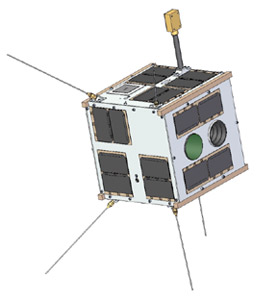BRITE-CA 1, 2 (BRITE-Toronto, BRITE-Montreal / CanX 3E, 3F) (original) (raw)
Please make a donation to support Gunter's Space Page.
Thank you very much for visiting Gunter's Space Page. I hope that this site is useful and informative for you.
If you appreciate the information provided on this site, please consider supporting my work by making a simple and secure donation via PayPal. Please help to run the website and keep everything free of charge. Thank you very much.

BRITE-CA (CanX 3) [UTIAS]
CanX-3 (Canadian Advanced Nanospace eXperiments), also known as BRITE (BRIght-star Target Explorer), is a mission planned to make photometric observations of some of the brightest starts in the sky in order to examine these stars for variability. The observations have a precision at least 10 times better than achievable using ground-based observations, and it is packaged inside a CanX-class nanosatellite.
The Principal Investigator for the BRITE mission is Emeritus professor Anthony F. J. Moffat D�partement de physique, Universit� de Montr�al. Prof. Jaymie Matthews (University of British Columbia), Prof. Stefan Mochnacki and Prof. Emeritus Slavek Rucinski (University of Toronto) are also part of the Canadian BRITE team. The Austrian Co-Principal Investigator is Professor Werner W. Weiss, University of Vienna.
The design is a 20 cm cube, chosen to accommodate the main telescope. It leverages a number of technologies qualified on CanX-2 and incorporates SFL's high-performance attitude control system, using reaction wheels developed in collaboration with Sinclair Interplanetary.
The two canadian satellites are copies of the Austrian BRITE satellites UniBRITE (CanX 3A) and TUGsat 1 (BRITE-Austria). One has an instrument sensitive to a blue (BRITE-Montreal) and the other with a camera optimized for a red wavelength range (BRITE-Toronto).
BRITE-CA 2 (BRITE-Montreal) failed to separate from the launch vehicle.
| Nation: | Canada |
|---|---|
| Type / Application: | Astronomy / Technology |
| Operator: | UTIAS (University of Toronto, Institute for Aerospace Studies) |
| Contractors: | UTIAS |
| Equipment: | |
| Configuration: | Gryphon Bus (GNB) |
| Propulsion: | None |
| Power: | Solar cells, batteries |
| Lifetime: | |
| Mass: | 10 kg |
| Orbit: | 613 km × 738 km, 97.9� (#CA1) |
| Satellite | COSPAR | Date | LS | Launch Vehicle | Remarks | |
|---|---|---|---|---|---|---|
| BRITE-CA 1 (BRITE-Toronto, CanX 3E) | 2014-033L | 19.06.2014 | Do LC-370/13 | Dnepr | with Deimos 2, KazEOSat 2, Saudisat 4, TabletSat-Aurora, BugSat 1, AprizeSat 9, AprizeSat 10, UniSat 6, BRITE-CA 2, Hodoyoshi 3, Hodoyoshi 4, Perseus-M 1, Perseus-M 2, Flock-1c 1, ..., 11, POPSAT-HIP 1, QB50P1, QB50P2, PACE, TigriSat, ANTELSAT, Lemur 1, NanoSatC-Br 1, Duchifat 1, PolyITAN 1, DTUSat 2, AeroCube 6A, AeroCube 6B | |
| BRITE-CA 2 (BRITE-Montreal, CanX 3F) | 2014-033AP | 19.06.2014 | Do LC-370/13 | p | Dnepr | with Deimos 2, KazEOSat 2, Saudisat 4, TabletSat-Aurora, BugSat 1, AprizeSat 9, AprizeSat 10, UniSat 6, BRITE-CA 1, Hodoyoshi 3, Hodoyoshi 4, Perseus-M 1, Perseus-M 2, Flock-1c 1, ..., 11, POPSAT-HIP 1, QB50P1, QB50P2, PACE, TigriSat, ANTELSAT, Lemur 1, NanoSatC-Br 1, Duchifat 1, PolyITAN 1, DTUSat 2, AeroCube 6A, AeroCube 6B / failed to separate from upper stage |
References:
- eoPortal Directory: BRITE (BRIght-star Target Explorer) Constellation / BRITE Canada
- BRITE-Constellation
- UTIAS: CanX 3 website
| | | | - |